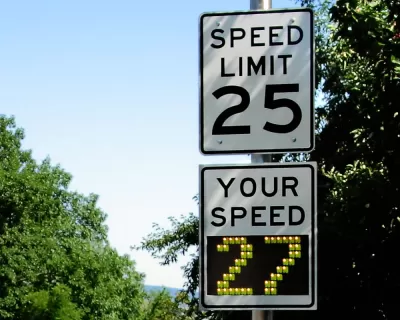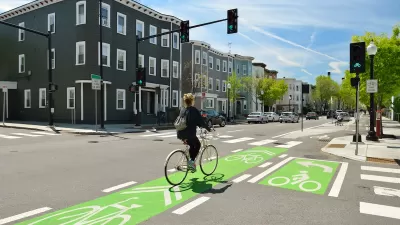Lower speed limits make cities safer, more livable, and, in the long run, more functional.

"The case for a fundamentally slower city has gained traction recently, especially in places where the rise of micromobility, the promise of autonomous vehicles, and the very-much-already-here problem of road congestion have converged, slowing drivers to a furious crawl," writes Andrew Small.
In the past, traffic jams were considered part of urban life, says Small, but drivers began to see speed as a right as cities changed and roads widened. Lately, however, a number of American cities have been moving back to lower speed limits, in response to both safety concerns and the diversifying of the mobility landscape.
"The most obvious immediate benefit to a fundamentally slower city is the safety boost it delivers. Reducing speeds is the best, easiest, and fastest way to quickly radically improve safety, for both drivers and anyone in front of them," says Small.
Technology, and the new modes that it has made possible, is also encouraging slower cities:
The micromobility revolution not only highlights a burgeoning need for more slow lanes: It can vividly illustrate the people-moving power of very modest speeds. When a dude on an electric scooter that rarely goes over 10 mph handily beats a BMW across town at rush hour, it’s easier to see how the scale of cities supports more-but-slower vehicles.
In addition, autonomous vehicles could help usher in a new era of slower-moving city streets. "If we can reconceptualize autonomous vehicles as low-speed machines trundling around downtown rather than interstate-eating robots tasked with making complex split-second driving decisions at highway velocities, everything gets less difficult," notes Small.
FULL STORY: Why Speed Kills Cities

Alabama: Trump Terminates Settlements for Black Communities Harmed By Raw Sewage
Trump deemed the landmark civil rights agreement “illegal DEI and environmental justice policy.”

Planetizen Federal Action Tracker
A weekly monitor of how Trump’s orders and actions are impacting planners and planning in America.

Why Should We Subsidize Public Transportation?
Many public transit agencies face financial stress due to rising costs, declining fare revenue, and declining subsidies. Transit advocates must provide a strong business case for increasing public transit funding.

Understanding Road Diets
An explainer from Momentum highlights the advantages of reducing vehicle lanes in favor of more bike, transit, and pedestrian infrastructure.

New California Law Regulates Warehouse Pollution
A new law tightens building and emissions regulations for large distribution warehouses to mitigate air pollution and traffic in surrounding communities.

Phoenix Announces Opening Date for Light Rail Extension
The South Central extension will connect South Phoenix to downtown and other major hubs starting on June 7.
Urban Design for Planners 1: Software Tools
This six-course series explores essential urban design concepts using open source software and equips planners with the tools they need to participate fully in the urban design process.
Planning for Universal Design
Learn the tools for implementing Universal Design in planning regulations.
Caltrans
Smith Gee Studio
Institute for Housing and Urban Development Studies (IHS)
City of Grandview
Harvard GSD Executive Education
Toledo-Lucas County Plan Commissions
Salt Lake City
NYU Wagner Graduate School of Public Service





























